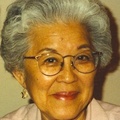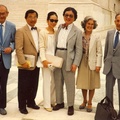Witness to a movement in the making
Professor Daniels’ admonition resonated among scholars and Nikkei community activists. A “Resolution Regarding Terminology” was adopted by the Civil Liberties Public Education Fund (CLPEF)–a body created in response to one of the recommendations of the Civil Liberties Act of August 10, 1988. The CLPEF resolution states that:
In the spirit of its mission, CLPEF Board is taking this opportunity to encourage the public, academia and governmental agencies to begin using accurate terminology with reference to the World War II internment [sic] experience. For instance, the terms ‘evacuation’ and ‘relocation’ have been widely acknowledged by historians and scholars as governmental euphemisms…. While the CLPEF does not want to dictate individual choice of vocabulary, it strongly urges grant applicants and the public at large to discontinue the usage of terms such as ‘relocation,’ ‘evacuation,’ and ‘assembly centers’ as clearly misleading references for this historic event...”1
The CLPEF resolution also cited the National Japanese American Historical Society (NJAHS) position on euphemisms:
The CLPEF concurs with the alternatives suggested by [NJAHS].... Specifically, rather than ‘evacuation’ or ‘relocation,’ the following terms for this event are more accurate: ‘imprisonment, incarceration, internment, detention, confinement or lockup.’ Rather than ‘assembly centers,’ the term ‘temporary detention centers’ is an accurate alternative; rather than ‘relocation camps,’ ‘internment camps, detention camps, prison camps, or concentration camps’ is more accurate; rather than ‘evacuee,’ ‘detainee, internee, inmate or prisoner’ is more accurate.2
While these manifestos reflected strong support for the need to revise the terminology, there was still much confusion and disagreement as to alternatives–a situation acknowledged in “A Note on Terminology” which introduces the “Terminology and Glossary” section on the home page of DENSHO, the online Japanese American Legacy Project that was founded in 1996 to collect and preserve oral histories of Nikkei:
At present there is no clear agreement about the most appropriate terminology for what Japanese Americans underwent during World War II. In the 1940s, officials of the federal government and the U.S. military used euphemisms to describe their actions against people of Japanese ancestry in the United States. The deceptiveness of the language can now be judged according to evidence from many sources, notably the government’s own investigation, as documented in Personal Justice Denied (1982), the report of the U.S. Congressional Commission on Wartime Relocation and Internment of Civilians....3
Nonetheless, the need to scrutinize and seek more accurate alternatives to the old euphemisms had come a long way. On the eve of a new century, there was a growing consensus of like-minded individuals, many of whom have been working toward the same goal but have never met or shared their notes. A movement was in the making, and a turning point came in August, 1995, when the Statue of Liberty-Ellis Island Foundation invited the Japanese American National Museum (JANM) to mount an exhibit called “America’s Concentration Camps: Remembering the Japanese American Experience” at the Ellis Island Immigration Museum.
JANM was created in 1984 as a non-profit institution housed in a former Buddhist temple in Los Angeles’ Little Tokyo. An invitation from a venerable site like the Ellis Island Museum was a wonderful opportunity to increase public awareness of the new museum as well as to educate a broader public to the Nikkei wartime imprisonment, but Jewish organizations and key individuals objected to “concentration camps” as a proper term to describe the Nikkei imprisonment. In January, 1998, Diane Dayson, superintendent of the Statue of Liberty National Monument, under which the Ellis Island Immigration Museum operates, told JANM executive director and CEO Irene Hirano that “she had received substantial expressions of concern from the National Park Service regional office about the use of the term ‘concentration camp’ in the title, as well as concern over possible negative response by the Jewish community.” Later in the same month, Dayson warned Karen Ishizuka, JANM curator of the exhibit, that
The Park continues to strongly oppose the use of the words ‘concentration camps’.... This phrase today is used to refer to death camps; New York City has a very large Jewish community that could be offended by or misunderstand the use of this phrase. In addition, National Park Service superiors are not so inclined to endorse the title because of the controversy that stems from this title.4
Ishizuka, who recently published a book recounting her experience with this issue, responded to Dayson that the JANM
…fully recognized and respected the unique horror of the Holocaust and that we were aware that throughout history there have been many injustices, no one of which mitigates or draws equivalency to the others. In addition, I pointed out that it was critical for the [JANM] to address the semantics of suppression to underscore the broader lesson that when innocent Americans were herded into what the government itself called concentration camps, it was a failure of democracy that affects all Americans. I ended with the assurance that the museum would continue its original plans to discuss the issue with the Jewish leadership and other community leaders in New York.5
The controversy became headline news: “…the Jewish-Japanese feud has become a tug-of-war between two successful ethnic groups, both trying to establish their status as history’s victims.”6 After interventions by historians like Roger Daniels, U.S. Senator Daniel Inouye, and a host of other intermediaries, a meeting between Nikkei and Jewish groups was held on March 9, 1998, where a compromise was worked out, whereby “an explanation–jointly authored–distinguishing the Nazi death camps from the American concentration camps be placed at the beginning of the exhibition. In this way the public would be further educated and it would be clear to all that no equivalency was intended.” The compromise was unanimously approved by the twenty-four persons in attendance, and Ishizuka and two members of the American Jewish Committee drafted the following statement which was adopted and placed at the beginning of the exhibition:
A concentration camp is a place where people are imprisoned not because of any crimes they committed, but simply because of who they are. Although many groups have been singled out for such persecution throughout history, the term ‘concentration camps’ was first used at the turn of the century in the Spanish American and Boer Wars.
During World War II, America’s concentration camps were clearly distinguishable from Nazi Germany’s. Nazi camps were places of torture, barbarous medical experiments, and summary executions; some were extermination centers with gas chambers. Six million Jews and many others, including Gypsies, Poles, homosexuals, and political dissidents were slaughtered in the Holocaust.
In recent years, concentration camps have existed in the former Soviet Union, Cambodia, and Bosnia.
Despite the difference, all had one thing in common: the people in power removed a minority group from the general population and the rest of society let it happen.7
A month later, on April 3, 1998, the exhibition opened, on time and with its original title intact: “America’s Concentration Camps: Remembering the Japanese American Experience.”8
Notes:
1. http://www.momomedia.com/CLPEF/background.html
2. National Japanese American Historical Society. Due Process–Americans of Japanese Ancestry and the United States Constitution, 1787-1994 (San Francisco, California: NJAHS, 1995), p. 48.
3. http://www.Densho.org. Densho is a nonprofit organization started in 1996 to document oral histories of Japanese Americans incarcerated during World War II, with the goal of educating, preserving, collaborating and inspiring action for equity.
4. Karen L. Ishizuka. “Coming to Terms,” an entire chapter on the Ellis Island Immigration Museum episode, in her book, Lost and Found: Reclaiming the Japanese American Incarceration (Chicago, Illinois: University of Illinois Press, 2006), p. 156. In his “Foreword,” Roger Daniels notes that, “Ishizuka was a key staff member for the first fifteen years of the museum’s existence. She helped establish the museum’s commitment to community as well as its Photographic and Moving Image Archive and Media Arts Center.” p. xiv.
5. Facsimile to Karen Ishizuka from Diane Dayson, Superintendent, Statue of Liberty National Monument, National Park Service, U.S. Department of the Interior, January 20, 1998. Ibid.
p. 157.
6. Ibid., p. 163.
7. Ibid., pp. 166-67.
8. Ibid., p.171.
*Note: This essay has circulated over the past decade among friends and research associates with the working title “Work in Progress: Terminology – WW II exclusion/incarceration of West Coast Japanese-Americans.” Copyright © 2009. Rev. 2010.
© 2009 Aiko Herzig-Yoshinaga




